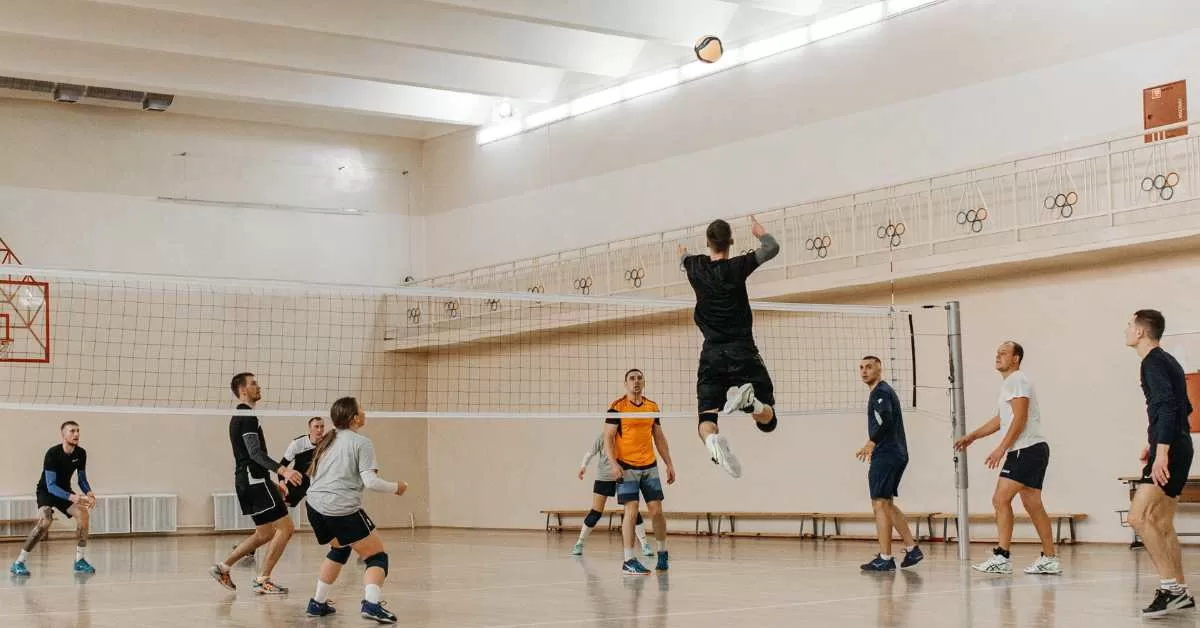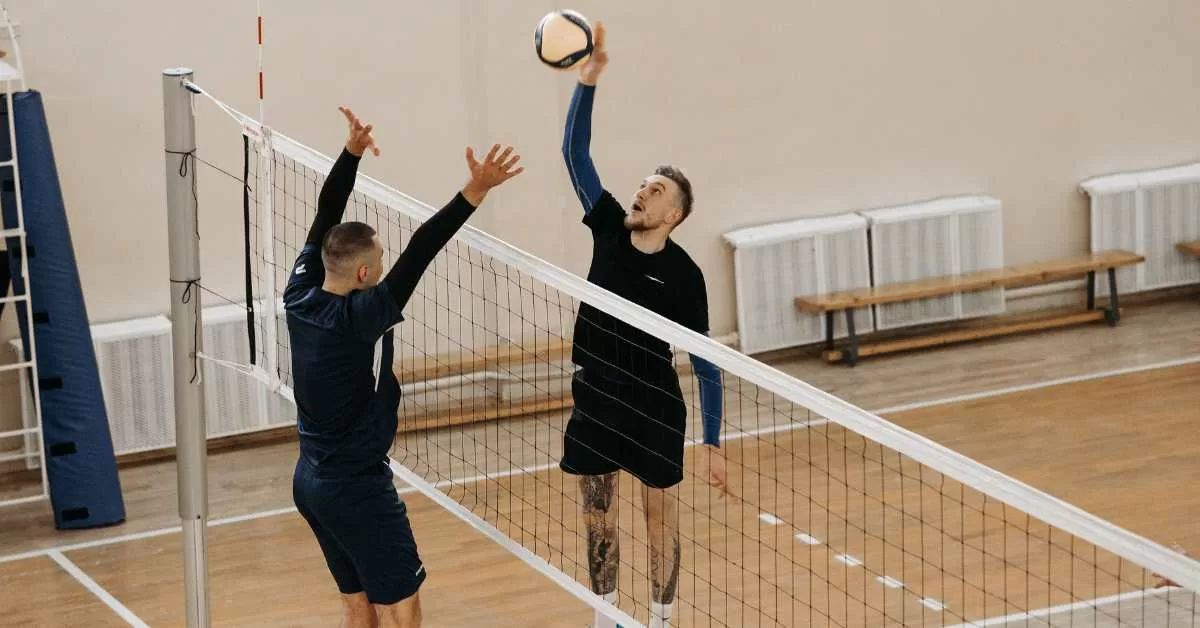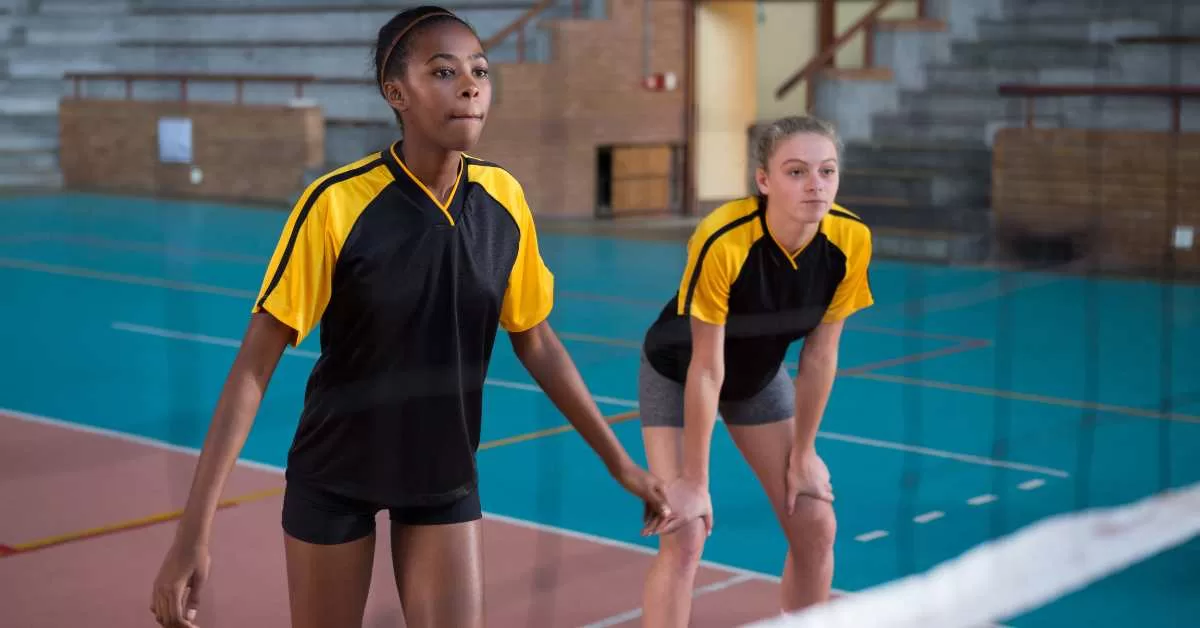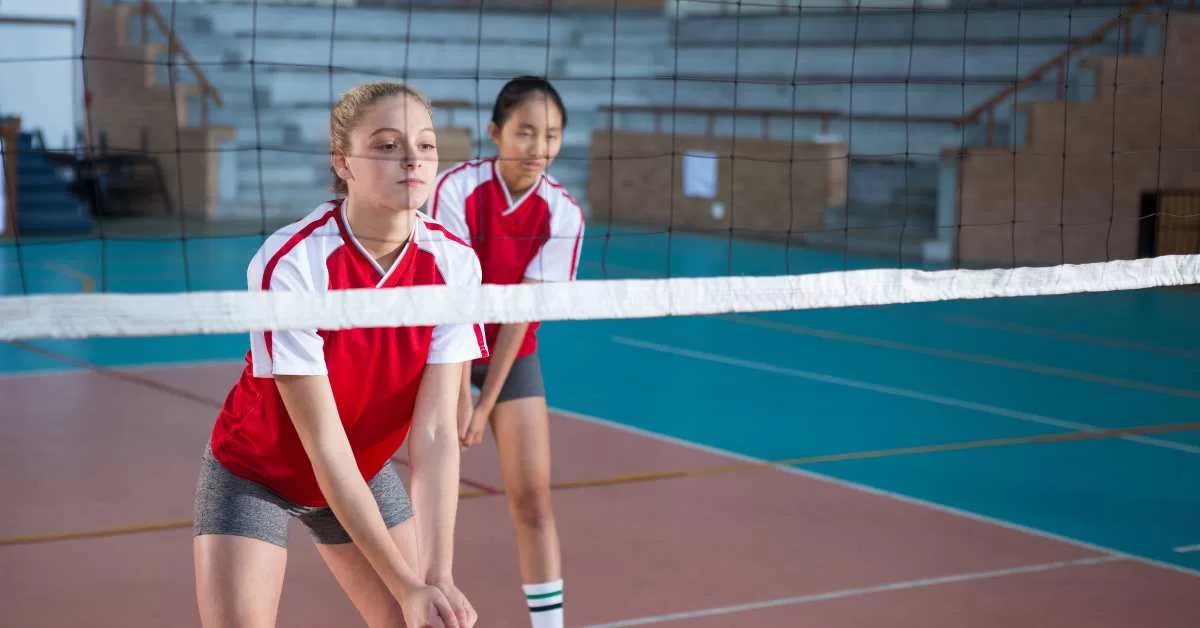The opposite hitter in volleyball also called the right-side hitter, is like the heavy hitter of the team. They’re usually really tall, strong, and athletic.
Their main job is to block the other team’s shots and smash the ball for points. I played this position for a while, so I know what it’s all about!
Opposite Hitter Volleyball Position: The opposite hitter in volleyball is a powerful player, usually tall and strong, tasked with blocking and attacking. They’re positioned opposite the setter and play a crucial offensive role.
In this article, we’ll explain what precisely an opposite hitter does and what kind of skills they need. Plus, we’ll share some tips to help you become a better right-side hitter. Let’s get started!
What’s the Job of an Opposite Hitter in Volleyball?

An opposite hitter plays on the right side of the volleyball court, either at position 2 or 1, depending on where they are on the court. They’re known for their offensive skills and aim to score points for the team.
1. Opposite Hitters Need to Stop the Opponent’s Outside Hitter
When the opposite/right-side hitter is in the front court, they face off against the other team’s left-side hitter. Their main job is to block the left-side hitter to stop them from scoring.
This is crucial because left-side attackers are strong and hit from the front, making them hard to block.
2. Opposite Hitters Must Serve and Play Defense Too
Opposite hitters also have to serve the ball and play defense in the backcourt. They should be able to dig the ball, even though they don’t pass as often.
3. Opposite Hitters Typically Aren’t the Primary Passers
Opposite hitters usually don’t do much passing. When they’re in the back row, they step aside to let outside hitters and the libero handle receiving serves.
4. Opposite Hitters Frequently Make Back Row Attacks
Opposite hitters do a lot of back-row attacks in volleyball. They often use a move called the “D ball,” which is a right-side attack from the back. This happens because when the opposite is in the back, the setter is in the front, giving the team more ways to score.
In this setup, the setter can either score by dumping the ball or set it for the outside, middle, or opposite hitters.
What Qualities Make a Strong Opposite Hitter?

Facing a really strong opposite hitter in volleyball can be intimidating. They’re usually taller, stronger, and more effective at scoring points than other players on the court.
1. Opposite Hitters Typically Have Impressive Height
Opposite hitters in volleyball are usually the second-tallest players, just a bit shorter than the middle blocker. Their height is important for two reasons.
First, they need to be tall to block well against the other team’s skilled outside hitter in the front row.
Second, they have to hit the D Ball, a back row attack from the right side, and being tall helps them hit the ball high so it’s hard to block and easier to score.
2. Left-Handed Players Are Often Exceptional Opposite Hitters
Hitting from the right side of the court is easier if you’re left-handed because you don’t have to reach across your body to hit the ball. Similarly, right-handed hitters prefer the left side.
3. Exceptional Opposite Hitters Possess Strength, Power, and Athleticism
Opposite hitters need to be not just tall but also very athletic. Being able to jump high is essential for both blocking and spiking. A strong and explosive upper body helps them hit the ball harder, especially when they’re attacking from the back row.
Is Being an Opposite Hitter a Desirable Volleyball Position?
I really like the opposite hitter position because you don’t have to do much passing, and I was good at hitting from the right side. Hitting from the back row is a fun challenge once you get used to it.
So, if you enjoy hitting and blocking, being an opposite hitter can be a fun choice. But if you struggle with hitting from the right side, you might not enjoy this position as much.
Is Becoming an Opposite Hitter the Right Choice for Me?

While it’s a fun position, being an opposite hitter doesn’t work for most volleyball players because it requires specific physical qualities that not everyone has.
The Key Physical Qualities of an Opposite Hitter
Being an opposite hitter is physically demanding, so you have to meet certain requirements to excel in this role at the highest level.
- Height is crucial for opposite hitters; at the highest level, men average 6’8.5″ and women 6’1″.
- Being left-handed is advantageous, but not essential.
- Athleticism and jumping ability are vital for blocking and spiking.
- Taller players have an advantage, but at lower levels, shorter players can still enjoy the position.
What Traits Are Coaches Seeking in an Opposite Hitter?
If you’re certain about pursuing the opposite hitter position, and you’re considering college volleyball or even a professional career, it’s crucial to assess your marketability as an athlete.
Criteria for Recruiting Opposite Hitters
Let’s see what scouts and coaches focus on when evaluating opposite hitters:
- A good height: Height is essential, especially for opposite hitters. Check out my full article for specific height benchmarks that can attract recruiters.
- Arm Length & Jumping Ability: Scouts look at how high you can jump and your arm length. While the exact numbers can vary, having a spike height of around 345 cm is a good starting point for college-level play, aiming for 350 cm or more over time. A block reach of 335cm or higher is also valuable.
- Club Volleyball Experience: Having 2-5 years of club volleyball experience at a decent level is important. Show that you know your way around the court to impress recruiters.
Improving Your Skills as an Opposite Hitter

To become a better opposite hitter, focus on the key attributes: physical prowess, athleticism, spiking skills, and blocking ability. Simplifying it, let’s look at the 20% of efforts that yield 80% of the results.
Here are the four most critical areas to invest your time and effort in for improvement.
1. Boost Your Jumping Ability
As a right-side hitter, jumping is crucial, especially if you’re not very tall. While some are naturally good at jumping, most of us aren’t. So, focus your training on improving your ability to jump higher, which is vital for spiking.
For international volleyball, male opposites should aim for a spike height above 350 cm, and women should target 320cm. Don’t forget to work on your upper body strength to hit the ball harder!
2. Enhance Your Jump Serving Skills
Your physical build makes you ideal for a super-strong top-spin jump serve. Tall players like you, especially middle blockers and opposites, often have the best jump serves because they hit the ball high and hard.
If you dedicate extra time each week to practice your jump serve, it could become a game-changer, earning you lots of points and making you a valuable player on the volleyball court.
3. Increase Your Right Side Attacks
To become a better hitter as an opposite, practice hitting more. It’s that straightforward. Team up with a setter and head to the court for extra work each week. If possible, find someone to block while you hit.
Be purposeful and stay focused to make real progress. Plan your practice, like hitting balls down the line, into corners, and off the block’s hands.
Avoid getting blocked. All you need is a net, a setter, and a fellow hitter or blocker who also wants to improve. There’s no excuse not to get more practice in.
4. Improve Your Back Row Attacking Skills
As an opposite hitter, you’ll do a lot of hitting from the back row. It’s essential to excel at the D ball, a back-row attack from the back/right side.
During your hitting practice, don’t just focus on front/right hits; have your setter set you back row attacks too. Concentrate on hitting the ball high and placing it in the back meter of the court.
What’s the Significance of the Opposite Hitter in Volleyball?
Having a good opposite hitter on your team is important for your offense. If they can hit well from the back row, it lets your team have a setter in the front, giving you more offensive choices.
A strong blocking opposite can also make it hard for the other team’s outside hitter. If your opposite hitter isn’t strong, your offense might rely too much on the outside hitter, making it tough to stop the other team.
FAQs About Opposite Hitter Volleyball Position
Q:1 What is the role of an opposite hitter in volleyball?
Opposite hitters, also known as right-side hitters, are primarily responsible for blocking and attacking on the right side of the volleyball court.
Q:2 What skills and qualities make a good opposite hitter?
A successful opposite hitter should possess height, strength, jumping ability, and solid spiking skills. They also need to be proficient at blocking and may benefit from being left-handed.
Q:3 Can shorter players excel as opposite hitters?
While height is an advantage, shorter players can still perform well as opposite hitters, especially at lower levels of play, if they have the necessary skills and athleticism.
Conclusion:
In conclusion, the opposite hitter in volleyball is like the team’s heavy hitter, responsible for blocking and smashing the ball on the right side. They’re usually tall, strong, and skilled at scoring points.
Becoming a great opposite hitter requires improving your physical abilities like jumping and hitting the ball hard. Plus, you should work on your jump serves and back-row attacks. While height helps, shorter players can still excel with the right skills.
Coaches look for these qualities when recruiting opposite hitters, like height and experience. Overall, it’s a challenging but rewarding position for those who fit the bill.
After reading this detailed article, we hope you have a good understanding of the Opposite Hitter Volleyball Position. If you have any questions, please don’t hesitate to ask in the comments!
